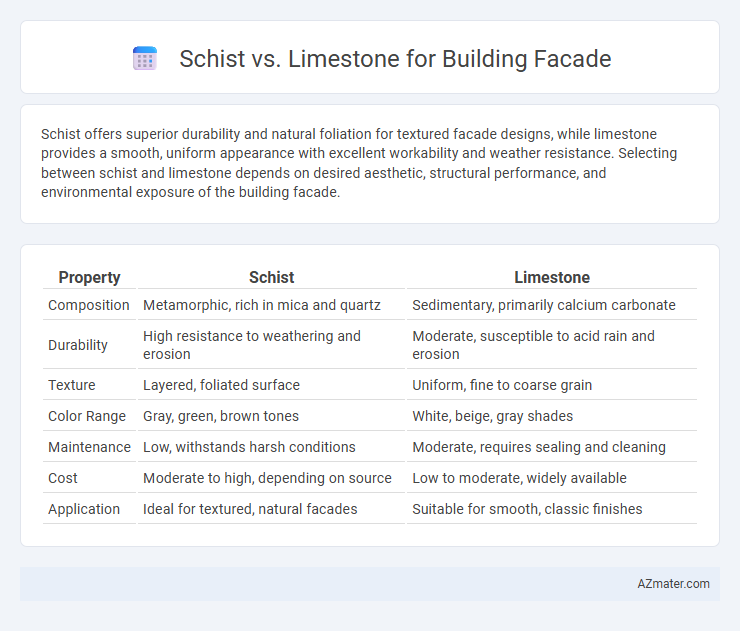Schist offers superior durability and natural foliation for textured facade designs, while limestone provides a smooth, uniform appearance with excellent workability and weather resistance. Selecting between schist and limestone depends on desired aesthetic, structural performance, and environmental exposure of the building facade.
Table of Comparison
| Property | Schist | Limestone |
|---|---|---|
| Composition | Metamorphic, rich in mica and quartz | Sedimentary, primarily calcium carbonate |
| Durability | High resistance to weathering and erosion | Moderate, susceptible to acid rain and erosion |
| Texture | Layered, foliated surface | Uniform, fine to coarse grain |
| Color Range | Gray, green, brown tones | White, beige, gray shades |
| Maintenance | Low, withstands harsh conditions | Moderate, requires sealing and cleaning |
| Cost | Moderate to high, depending on source | Low to moderate, widely available |
| Application | Ideal for textured, natural facades | Suitable for smooth, classic finishes |
Introduction to Schist and Limestone as Building Facade Materials
Schist and limestone are popular natural stone materials used for building facades due to their durability and aesthetic appeal. Schist, a metamorphic rock characterized by its foliated texture and shimmering mica content, offers strength and unique visual patterns, making it ideal for decorative exterior cladding. Limestone, a sedimentary rock composed mainly of calcium carbonate, provides a smooth surface and timeless elegance while demonstrating good weather resistance when properly treated for facade applications.
Geological Formation and Composition
Schist is a metamorphic rock formed under high pressure and temperature conditions, characterized by its foliated texture and abundant mica and quartz minerals, making it durable and visually layered for building facades. Limestone, a sedimentary rock primarily composed of calcium carbonate from marine organisms, offers a smoother, lighter appearance but is more susceptible to weathering and acid rain. The geological formation of schist involves regional metamorphism, while limestone forms through the accumulation and compaction of biological debris in shallow marine environments.
Aesthetic Qualities and Visual Appeal
Schist offers a striking visual appeal with its layered texture and natural shimmer from mica, creating dynamic depth and variation on building facades. Limestone provides a classic, smooth, and uniform appearance, often in soft beige or gray tones, enhancing elegance and timelessness. The choice between schist and limestone hinges on desired aesthetic impact--schist emphasizes rugged, natural beauty, while limestone delivers refined subtlety and sophistication.
Durability and Weather Resistance
Schist offers high durability and superior weather resistance due to its foliated structure, making it resistant to freeze-thaw cycles and erosion compared to limestone. Limestone, while aesthetically pleasing and easier to carve, is more porous and susceptible to acid rain and weathering over time. For building facades exposed to harsh climates, schist provides a longer-lasting, low-maintenance option with enhanced protection against environmental degradation.
Workability and Installation Process
Schist offers superior workability for building facades due to its natural cleavage, allowing easier splitting into thin slabs and precise shaping during installation. Limestone, while denser and less prone to weathering, demands careful cutting and anchoring because of its uniform texture and softer composition. The installation process for schist benefits from faster adjustments on site, whereas limestone requires specialized tools and skilled labor to maintain structural integrity and aesthetic consistency.
Maintenance Requirements and Longevity
Schist offers higher durability and weather resistance than limestone, resulting in lower maintenance requirements for building facades. Limestone, while aesthetically appealing with its smooth texture, is more porous and susceptible to erosion and staining, necessitating more frequent cleaning and sealant applications. Over time, schist's dense and foliated structure contributes to greater longevity, making it a preferable choice for demanding architectural environments.
Cost Comparison and Budget Considerations
Schist generally presents a higher initial cost than limestone due to its durability and unique texture, which can increase the overall budget for building facades. Limestone offers a more affordable option with easier sourcing and installation, making it suitable for projects with stricter budget constraints. When considering long-term expenses, limestone may incur additional maintenance costs, while schist's robustness can provide better value over time despite the upfront investment.
Environmental Impact and Sustainability
Schist, characterized by its foliated texture and durability, has a lower carbon footprint in quarrying and processing compared to limestone, which involves more intensive calcination emitting significant CO2. Schist's natural resistance to weathering reduces maintenance frequency, enhancing facade longevity and minimizing resource consumption over time. Limestone, although popular for aesthetic versatility, is more susceptible to acid rain and erosion, potentially increasing environmental costs for repairs and replacements in building facades.
Popular Architectural Applications
Schist and limestone are popular choices for building facades due to their distinct aesthetic and structural properties. Schist, with its layered texture and natural sheen, is favored in contemporary and rustic architectural designs for its durability and unique visual appeal. Limestone's soft, uniform appearance lends itself to classical and Mediterranean-style buildings, providing excellent weather resistance and ease of carving for intricate details.
Choosing the Right Material for Your Project
Schist offers a durable, textured surface with natural cleavage planes ideal for rustic or naturalistic facades, while limestone provides a smooth, uniform appearance suitable for classical and modern architectural styles. Consider factors such as climate resistance, maintenance requirements, and aesthetic goals; limestone is more porous and may require sealing in wet environments, whereas schist's foliated structure offers enhanced water drainage and weathering durability. Evaluating local availability and project budget also impacts the choice, as limestone tends to be more widely accessible but potentially costlier than regional schist varieties.

Infographic: Schist vs Limestone for Building Facade
 azmater.com
azmater.com